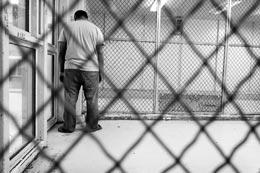Electronic surveillance not an alternative to migrant detention

Guest commentary
By Harsha Walia and Syed Hussan
A coroner’s inquiry was held recently in Vancouver on Lucia Vega Jimenez’s suicide in Canadian Border Service Agency (CBSA) custody.
Immigration detainees are also on strike in Ontario, and a Red Cross investigation of Canadian Border Service (CBSA) facilities – described as dungeons by some lawyers – has just come to light. The Red Cross found over-crowding, inadequate mental health supports, a lack of support for detained children, and presence of mold in detention cells. Many of these shortcomings constitute a failure to comply with national and international standards.
For the first time in a long time, immigration detention is getting the scrutiny it deserves. In response, CBSA is trying to change tracks. Its most recent move is introducing the idea of electronic monitoring systems as an alternative to immigration detention.
As community members that work closely with immigration detainees, we believe electronic monitoring is not a just alternative to immigrant detention.
Sanctioning electronic monitoring assumes that there is a rational and legitimate reason for someone to be under surveillance. Based on research in the criminal justice system, the John Howard Society has found, “There is considerable evidence that electronic monitoring has widened the corrections net by providing a more intrusive and expensive alternative, not to incarceration, but to regular probation and other community sanctions. Unfortunately, this outcome runs contrary to the original intent of those who conceived of, and developed, electronic monitoring programs – to reduce the number of inmates in correctional facilities.”
Similarly, in the realm of immigration detention, the process to jail immigrants is so unjust that invasive surveillance (which presumes guilt) simply cannot be justified.
Migrants are the only population within Canada who can be incarcerated simply on administrative grounds without being charged with a specific criminal offence. This makes migrant detention incredibly arbitrary and can lead to indefinite detention. Over the past 10 years there has been an average of 11,000 migrant detentions per year, including up to 807 children detained each year. In 2013, migrant detainees spent a whopping total of 183,928 days (that’s over 503 years) in immigration detention.
According to our recent ground breaking research report, fewer migrants are being released from detention each year, with a national release rate average of just 15 per cent. Our research has also shown that the detention review process is inconsistent to the point of being unacceptable: the rate of release varies from 5% to 38% depending on the Immigration and Refugee board member (who is a civil servant appointee, not a lawyer or judge). Release rates also vary by region, from 9% in Ontario to 27% in Western Canada. On top of that, these detention reviews are themselves administrative processes: no avenues exist for detainees to appeal detention reviews decisions in front of a judge to secure their release.
There are countless cases of people behind bars for one year, four years, six years, with no release date in sight. We have fought and won release for men like Martin Sisay who was detained for 38 months without trial or charge, Nader who was detained for six years because he refused to sign documents to consent to his own deportation, and Muhammad Sillah who was detained for 10 months despite there being a stay on his deportation and a spousal sponsorship application in process.
Since Canada is one of the only Western countries that has not limit on detentions pending deportation, electronic monitoring would mean that migrants could essentially be locked indefinitely into surveillance.
It is evident that the immigration detention system does not need new technology to become cheaper and more humane; it needs a fundamental transformation. At the very least, no migrant must be detained in maximum security prisons, there should be a 90 day limit on detentions pending deportation, and the entire detention review system must be overhauled. Even the UN High Commissioner for Human Rights’ Working Group on Arbitrary Detentions has recently insisted that immigration detention in Canada should be the last resort and for the shortest time possible.
Furthermore, by suggesting that the solution is shifting from incarcerating refugees behind bars to bordering their own bodies, CBSA is detracting from the central reasons that people are vulnerable in the first place.
Shifting to GPS units will not resolve the core issue of why people are being caught, tracked and deported at increasing rates. Fear of deportation is what was causing Lucia distress and anxiety, ultimately causing her to take her own life. Electronic monitoring is therefore not a reasonable alternative to detention because migrant detention and deportation is increasingly unreasonable, arbitrary, and in contravention to international norms. It must end.
Harsha Walia is a member of No One Is Illegal in Vancouver. Syed Hussan is a Toronto based researcher, writer and migrant justice organizer with No One Is Illegal – Toronto and the End Immigration Detention Network.









